Early televisions in homes
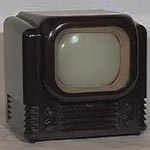
Early televisions were of great interest to people of the time who had been used only to sound via the wireless (radio). This page lets you into their mindset as it is packed with experiences from people who were there at the time. Topics included are the stimulus for owning a television, whether to buy or rent, size and appearance, picture quality, controls, screen magnifiers and gadgets to suggest colour televisions in what was then the future.
____
by Neil Cryer whose family had an early television, with firsthand contributions from others
The television in the home
Although BBC (British Broadcasting Corporation) started broadcasting television in 1936, televisions did not catch the public interest until the coronation of Queen Elizabeth II in 1953. The new enthusiasm was due to the BBC announcing that the coronation was to be televised. This was something new and very special indeed at that time, and family was among those who bought a television for the occasion.
It is only fair to point out that it was only the better-off families who bought televisions in then. My father was a senior engineer and although this certainly didn't make us wealthy, he probably brought in more income than the average man in the street.
I was a teenager at the time, and wasn't particularly interested in the coronation. I was more interested in the television itself and how it entertained us afterwards.
Appearance of early televisions
Our television, like all televisions at that time was a bulky piece of polished wood furniture. Others were in boxes made of bakelite, an early and brittle form of plastic.
Our screen was tiny - only 9 inches, measured diagonally, i.e. just under 23 centimetres, and the programmes were in black and white. Nevertheless we thought it wonderful, as previously we had had to go to the pictures (cinema) to see moving pictures.
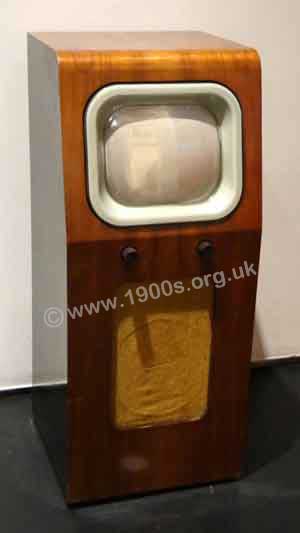
Early television in a bulky wooden cabinet, photographed in Brooklands Museum.

An early television in bulky case made of bakelite which could sit on an existing table. Photographed at an exhibition.
The more expensive televisions had doors to cover the television screen when not in use, so hiding the function of the television and making it look like another dark wood piece of furniture.
Poor picture quality: 405-lines and 625 lines
contributed by Jan Clifford, early electronics enthusiast
Picture quality of these early televisions was poor. It was largely a matter of 'numbers of lines'. Let me explain. In the early televisions, a cathode ray fired horizontal lines onto the inner face of a television tube 24 times a second. There were 405 lines which covered the whole screen. Even when the Pye company offered a bigger screen (perhaps as big as fourteen inches from corner to corner) the picture was not in the least any clearer because the number of lines was the same. It was just that the blank spaces between the lines were wider.
Later televisions were manufactured with 625 lines which promised much greater clarity, but picture quality was a far cry from that of today's televisions.
Shape of early television tubes
contributed by Douglas Adam, amateur historian
Early television tubes had rounded ends which were the television screens, and it was only the casing that made them appear rectangular.
Television screen magnifiers
Because the picture on these old televisions was so poor, some families attached screen magnifiers over the screens. My family didn't, but I did see them in use elsewhere and didn't like them. As the lenses were necessarily thick, they distorted badly for anyone not directly in front - not ideal for large families sitting around the room.
Types of screen magnifier
contributed by Douglas Adam
The earliest screen magnifiers were made of a sandwich of Perspex/Lucite, with the cavity filled with a clear liquid, possibly something like a mineral oil. I worked briefly in a television shop in my youth and I seem to remember that there was a bubble inside the magnifier. The rear sheet was flat, while the front sheet had a flat surround (for cementing to the rear) with the central area hot formed, probably under vacuum, to the appropriate lens shape.
These television magnifiers were heavy. Some had floor-stands while others had a strap system hanging over the top of the TV.
A newer and lighter type of screen magnifier came in with the larger 14 inch televisions. It was a flat Fresnel lens (a composite of thinner rings), though it, too, had viewing angle limitations. Also it cut down brightness.
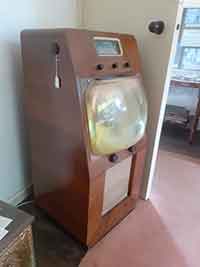
A television magnifier attached onto the screen
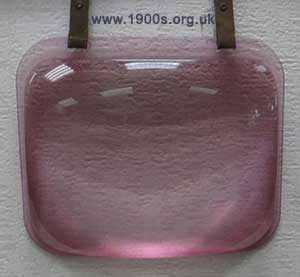
A television magnifier with straps for hanging over the top of the screen
Television appearance improves
Over the next few years, televisions became more popular in the home. By the 1960s the majority were no longer housed in such bulky cabinets, and screens had become slightly larger. However, everything else that follows on this page still accurately describes them. They were a far cry from modern televisions: no colour, very poor resolution, tendencies for the picture to continually drift up or down, no remote controllers and frequently breaking down. There was a control that viewers could twist to bring the drifting movement back to normal, but it had to be used too often for comfort.
Television aerials
To get the best picture quality from these old televisions, the position of the aerial was crucial. Aerials on rooftops were the norm, and often residential roads had a 'roofscape' of H-shaped aerials all along the road. I wish there was a picture to show you.
The television controls
All the television controls were knobs that needed to be twisted manually to make adjustments. Apart from the obvious 'on-off' knob and the 'volume' knob, the ones that we had to use a great deal were the 'horizontal hold', the 'vertical hold', 'brightness' and 'contrast'. The vertical hold controlled the vertical drift up or down and the horizontal hold controlled the screen going jazzy. There was no control for changing programmes as there was only the one programme broadcast by the BBC.
There was of course no remote control. So it was unusual to be able to sit through a programme without having to get up to make some sort of adjustment.
Sensitivity of early televisions
contributed by Jan Clifford
Unlike wartime wireless sets which were sometimes found to be still working even after the ill-effects of a bomb blast, television sets were frighteningly sensitive. A slight bump could turn the picture into jumbled grey jibberish - only recovered by turning off the set, letting it cool down completely and then switching it back on wih the hope that it had 'sorted itself out'.
To buy or to rent?
The television worked with valves which had a habit of blowing and were expensive to replace. So although my parents bought our first television, they, like most other people, soon resorted to renting. Renting was a type of insurance because it became the rental firm's responsibility to undertake all repairs free of charge.
The renting firm was called Radio Rentals, so presumably it rented out radios too. In retrospect, its name was rather surprising since everyone at the time still referred to a radio as a wireless.
Television programmes and intervals
Because television was so new, the programmes were based on known entertainment at the time: the theatre, cinema or street and park entertainment. So it was quite normal to have an interval in a programme to give viewers the chance to make a cup of tea. I particularly remember goldfish swimming around the screen during these intervals. The end of the interval was signalled by the sound of a ringing bell.
The programmes were transmitted from the Alexandra Palace and there was of course only one channel. The early programs were only transmitted for a few hours each day.
I particularly remember puppet shows for children, rather along the lines of the old Punch and Judy shows.
How films were shown on early television
contributed by Jan Clifford
A means of showing pre-recorded films on television was a very long time into the future. So what was shown was always live. The BBC had a device which projected the film onto a white screen which was itself broadcast live through a television camera.
The television test card
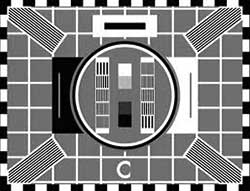
Early test card for black and white televisions
A test card was screened before the main transmission. It showed various shades of grey and lines in various direction so that the brightness and contrast controls could be suitably adjusted.
The beginnings of colour television
An attempt at colouring the screen before true colour television
contributed by Douglas Adam
Before true colour television was invented, there was a screen add-on which was a flat plastic sheet, thin but not flimsy, that had the top area tinted blue, and the bottom tinted green. It did add some sort of colour to the programmes, but it did not reproduce colour accurately.
A first experience of colour television
I first saw a display of what was said to be colour television at the 1951 Festival of Britain. It was displayed next to a screen of identical size showing the same programme on a standard black and white screen. The colour was so pale that I had to look carefully to see any difference between the two screens.
from the webmaster
Weather forecasts
There were no modern computer graphics. So the television weather forecasters showed the expected weather with pieces of felt, shaped and coloured to indicate rain, sun, cloud etc and they moved these around over a felt background. Because felt sticks loosely to felt, it can be moved around easily.
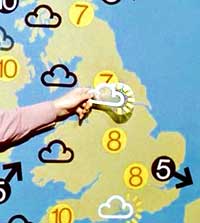
Felt display board, with a person moving the cloud and rain shape to where on the map it was forecast
Felt graphics like these were common, particularly in infant schools. In motherhood classes when I was expecting my first baby, I was taught what food was good for me from a nurse who stuck coloured pieces of felt shaped like fish, butter, milk, cheese, vegetables etc onto a felt background.
| sources | webmaster | contact |
Text and images are copyright
If you can add anything to this page or provide a photo, please contact me.



